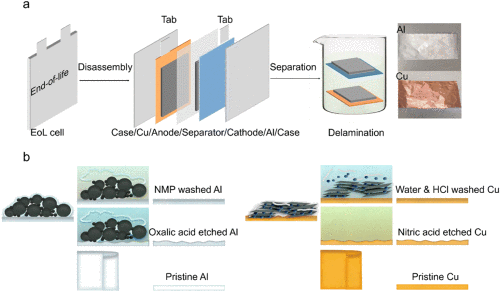Researchers from The University of Birmingham in the UK have demonstrated that the direct reuse of aluminum and copper current collectors from spent lithium-ion batteries (LIBs) is possible. An open-access paper on their study is published in the RSC journal Green Chemistry.
The ever-increasing number of spent lithium-ion batteries (LIBs) has presented a serious waste-management challenge. Aluminium and copper current collectors are important components in LIBs and take up a weight percentage of more than 15%. Direct reuse of current collectors can not only effectively reduce LIB waste and provide an alternative renewable source of aluminum and copper, but also prevent long manufacturing processes and energy input for new current collectors. Herein, aluminium and copper current collectors are reclaimed from commercial spent LIBs with simple chemical treatments and we illustrate their successful reuse for LiNi0.6Mn0.2Co0.2O2 cathodes and graphite anodes, respectively.
The reclaimed current collectors treated with different processes show different surface compositions and morphology to pristine ones, resulting in distinctive wettability, adhesion strength and electrical conductivity. The reused current collectors show similar electrochemical performance to the pristine one at low C rates, while extra caution should be taken at high C rates for aluminium current collectors due to relatively low contact conductivity.
Most recycling studies have been focusing on electrode active materials, with while less attention to inactive components such as current collectors, separators, electrolytes, and cases. In this study, the researchers investigated different treatments for delaminating the used Al and Cu current collectors, examining the effects of resulting surface morphologies on the wetting of electrode slurries, adhesion strength and electrical conductivity.

